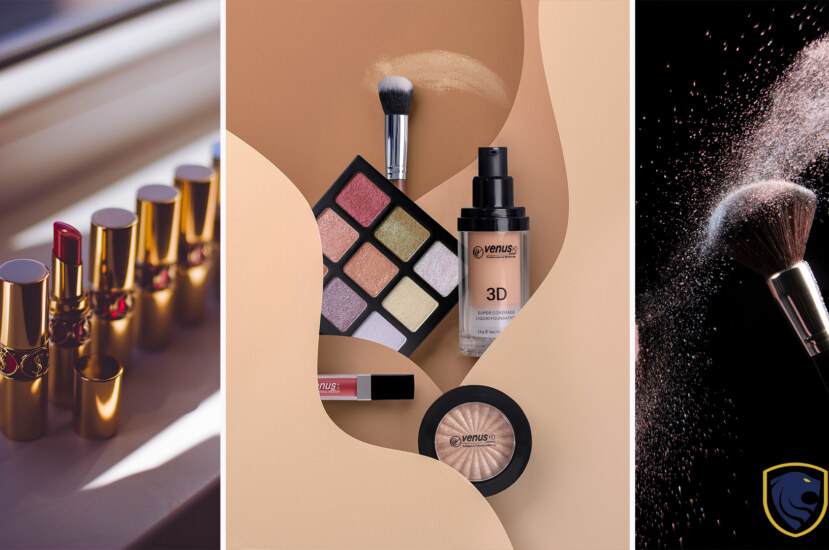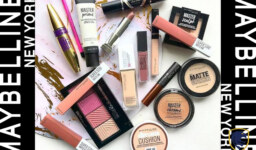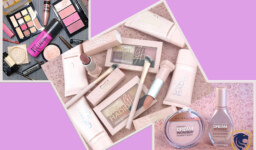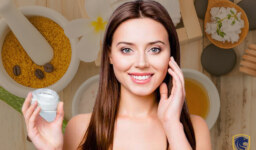Step into the realm of cosmetic products and take a tour inside your makeup bag as we look at the basic elements that define your beauty regimen. Each component, from the delicate shimmer of Mica to the matte finish offered by Talc, plays an important role in producing the looks you adore. This investigation will delve into the science and creativity behind the most prevalent ingredients in cosmetics products. You’ll get insight into how these substances add to the attraction of cosmetics as we reveal the mysteries of Dimethicone’s velvety touch, the brilliance of Iron Oxides, and the enchantment of Beeswax. Join us as we explore the world of Carnauba Wax’s structural marvels and the texture-enhancing enchantment of Silica.
As we explore the world of cosmetic chemistry, we’ll learn how Titanium Dioxide protects your skin and Mica adds shine. Prepare to learn the story behind the chemicals that enrich your everyday beauty routines. This tour will give you a greater understanding of the science and workmanship that turn your beauty regimen into an art form.
Titanium Dioxide
Titanium Dioxide, a mineral, is a common component in cosmetics. It has several advantages, the most important of which is that it acts as a sunscreen. It gives natural, opaque coverage that evens out skin tone in foundations and powders. Its UV-blocking ability protects the skin from damaging rays, making it a popular ingredient in sun protection cosmetics. The capacity of titanium dioxide to scatter light gives a soft-focus effect, which minimizes the appearance of flaws and tiny wrinkles. It plays an important role in pigmentation in mineral-based cosmetics, providing rich colors to eyeshadows, blushes, and lip products. Its non-irritating nature is ideal for delicate skin, making it a popular ingredient in a variety of cosmetics.

Titanium Dioxide
As a finely milled component, it gives powders a smooth texture, improving their application and finish. Although Titanium Dioxide is beneficial to most people, those with darker skin tones may find it difficult to use owing to the possibility of a white cast. Recognizing Titanium Dioxide’s varied role in cosmetic products adds an intelligent dimension to our beauty choices. When we look into our cosmetic bags, we see that this chemical protects us from the sun’s rays while also adding to the palette of colors that enrich our expressions.
Iron Oxides
Iron oxides, which are adaptable pigments, play an important function in cosmetics. These natural substances are responsible for our faces’ brilliant colors. They add color to a wide range of cosmetics, from foundations to eyeshadows. Earthy reds, warm oranges, and deep browns combine to produce a palette that is suitable for a wide range of complexion tones. Their opacity guarantees that cosmetics have a genuine color payoff, even on different skin tones. Because of their stability, iron oxides keep their brightness without fading, making cosmetics last longer. Their natural propensity to attach to skin extends the life of goods. Iron oxide is used in eyeshadows and eyeliners to provide the drama and depth that is needed in eye makeup.

Iron Oxides
Despite their widespread usage, allergic responses to Iron Oxides are uncommon, making them a safe choice for the majority of people. While they add beauty to our cosmetics, it’s crucial to remember that Iron Oxides vary in color and particle size, which affects the final effect. Iron Oxides show their artistic nature as we explore our cosmetic bags, painting our canvas with a diversity of colors that characterize our beauty expressions.
Mica
Mica, a sparkling stone, lends a magical touch to cosmetics. It’s the key to achieving that glowing shine on our faces. This naturally occurring mineral reflects light, giving it a dazzling appearance. It gives highlighters a dazzling gloss that highlights our features. Also, mica’s versatility makes it a go-to ingredient in eyeshadows, imparting a delicate shine to our lids. It adds a gentle brightness to foundations, improving the look of our skin. Moreover, mica’s lightweight texture promotes a comfortable fit and prevents a thick, cakey appearance. It’s also ideal for day-to-night transitions, providing glitz without overdoing it. Mica gives a transparent finish in loose powders, which minimizes flaws. Its refractive qualities blur the appearance of tiny lines and pores.

Mica
While Mica is a beauty enhancer, its source must be considered. Ethical and sustainable practices guarantee that it is used responsibly. It’s worth mentioning that certain people may be sensitive to bigger particles, producing moderate discomfort. Mica lights our look as we dig into our cosmetic bags, reminding us of its capacity to collect and reflect light. It’s the key to our brilliant confidence and the glimmer in our eyes.
Talc
Talc, a versatile mineral, has a role in cosmetics. It’s well-known for its oil-absorbing properties, making it a popular powder component. Talc provides a matte finish in foundations and setting powders, reducing unnecessary shine. Its delicate texture enables seamless application, preventing makeup from seeming heavy. The ability of talc to give a velvety texture is especially advantageous in blushes, as it improves bendability. It’s used in eyeshadows, where it ensures color payoff and prevents creasing. Talc’s ability to manage moisture helps to keep makeup from smearing or caking. However, it is essential to be careful of sensitivity – some people may have skin irritation as a result of Talc’s inherent impurities. This danger is reduced by using cosmetic-grade Talc in cosmetic products.

Talc
Talc has been the subject of debate owing to possible health risks when used in big quantities. Alternatives such as finely powdered silicates are now being used by cosmetic businesses. As we go deeper into our cosmetic bags, Talc proves to be a dependable workhorse, providing a smooth canvas and a mattifying touch. It’s an essential element in achieving a perfect finish, demonstrating its enduring relevance in the cosmetics industry.
Silica
Silica, a hidden multitasker, makes its way into cosmetics. It’s an underappreciated champion for those looking for a matte finish. Silica absorbs excess oil in powders, resulting in a natural, shine-free finish. Also, its delicate texture promotes comfort without becoming cakey. Silica, as a fine powder, smoothest the look of skin while dispersing flaws. Moreover, it works well as a primer, laying down a foundation for makeup application. Silica is frequently used in liquid foundations to provide a soft-focus effect that reduces the appearance of tiny wrinkles. Its porous structure aids in the retention of cosmetics for several hours. While most people tolerate silica well, individuals with sensitive skin may experience slight discomfort. It is critical to use cosmetic-grade Silica for maximum safety. Further, the versatility of silica extends to the transparency of cosmetics.

Silica
It blurs lines without changing the color of transparent powders. Silica’s touch becomes apparent as we investigate our cosmetic bags – a weightless veil that guarantees our makeup stays fresh and faultless. So, it’s the secret of a matte canvas that gives us the courage to face the day.
Dimethicone
Dimethicone, a cosmetic workhorse, is widely used in cosmetics. It’s a silicone-based component that gives the product a silky-smooth feel. Dimethicone offers a silky base in primers, ensuring uniform makeup application. Also, it gives a faultless canvas in foundations, filling up fine wrinkles and pores. Dimethicone’s water resistance extends the life of cosmetics by reducing smearing and fading. It’s also used in lip cosmetics, where it provides a gentle, glide-on texture. Because of its non-comedogenic properties, dimethicone is a common ingredient in many formulations. Those who are allergic to silicone, on the other hand, should use caution. Because of its occlusive nature, it can occasionally trap oils beneath the surface, causing outbreaks in certain people. Using oil-free formulations or doing patch testing can help reduce possible responses.
Dimethicone
Dimethicone’s smoothing properties make it a vital tool for achieving a perfect cosmetic finish. In investigating our cosmetic bags, we notice Dimethicone’s influence – a velvety touch that primes, perfects and extends the hold of makeup. So, it’s the unseen helper that ensures our makeup application goes as smoothly as possible.
Carnauba Wax
Carnauba Wax, a natural marvel, is found in cosmetics. It is derived from palm leaves and adds structure and texture. Carnauba Wax thickens and volumizes lashes with mascara, producing a dramatic look. It’s also an important element in brow cosmetics, as it helps shape and keep brows in place. Because of its natural nature, Carnauba Wax is popular among people seeking natural beauty products. Its waxy texture forms a protective barrier, aiding in the retention of moisture in lip products. The emollient characteristics of Carnauba Wax aid in the smooth application of lipstick and lip balms. However, because of its thickening properties, Carnauba Wax may not be ideal for all recipes. It can occasionally have a weighty feel to it.

Carnauba Wax
Carnauba Wax’s position in our cosmetic bags becomes clear as we dig deeper. It’s the sculptor molding our lashes and brows, as well as adding structure to our lip products. Also, it’s the natural element that gives our cosmetics texture and durability, embracing the beauty of clean and effective formulas.
Beeswax
Beeswax, a natural beauty ally, is essential in cosmetic products. It’s a versatile substance derived from bee colonies. Beeswax offers thickness and structure to lip products, helping lipsticks and balms keep their form. Its emollient properties keep lips moisturized. The natural origin of beeswax corresponds to clean beauty standards. It’s also used in cream-based cosmetics, such as blushes and eyeshadows, where it adds texture and aids in blending. Moreover, beeswax works as a binder, allowing cosmetics to stick to the skin for a longer period. Its ability to build a barrier seals in moisture, making it suitable for creams. Although bee products are typically well accepted, anyone who is allergic to them should exercise caution. Exploring our cosmetic bags reveals Beeswax’s role: it’s the sculptor molding our lip products and the binder keeping our creams in place.

Beeswax
It is a natural element that blends beauty with functionality, providing structure and sustenance. So, the prevalence of beeswax in cosmetic products demonstrates the beauty industry’s embracing of nature’s offers.




